San Francisco
A rapidly growing wildfire south of Lake Tahoe jumped a highway, prompting more evacuation orders and the cancellation of an extreme bike ride through the Sierra Nevada on Saturday as critically dangerous wildfire weather loomed in the coming days.
The Tamarack Fire, which was sparked by lightning on July 4, exploded overnight and was over 32 square miles (82 square kilometers) as of Saturday evening, according to the Humboldt-Toiyabe National Forest.
The blaze was threatening Markleeville, a small town close to the California-Nevada state line.
It has destroyed at least three structures, authorities said, and was burning toward the Alpine County Airport after jumping a highway.
A notice posted on the 103-mile (165-kilometer) Death Ride’s website said several communities in the area had been evacuated and ordered all riders to clear the area. The fire left thousands of bikers and spectators stranded in the small town and racing to get out.
Kelli Pennington and her family were camping near the town Friday so her husband could participate in his ninth ride when they were told to leave.
They had been watching smoke develop over the course of the day, but were caught off guard by the fire’s quick spread.
“It happened so fast,” Pennington said. “We left our tents, hammock and some foods, but we got most of our things, shoved our two kids in the car and left.”
Saturday’s ride was supposed to mark the 40th Death Ride, which attracts thousands of cyclists to the region each year to ride through three mountain passes in the so-called California Alps. It was canceled last year during the coronavirus outbreak.
Paul Burgess, who drove from Los Angeles to participate in the ride, said most of the cyclists he met were thankful to steer clear of the fire danger.
“They just said this is just how it goes,” Burgess said. “It’s part of climate change to a certain extent, it’s part of just a lot of fuels that are not burnt, the humidity is low, the fuel moisture levels are low, and … around the state, many parts of it are much like a tinderbox.”
Afternoon winds blowing at 20 to 30 mph (32 to 48 kph) fanned the flames as they chewed through bone-dry timber and brush.
Meteorologists predicted critically dangerous fire weather through at least Monday in both California and southern Oregon, where the largest wildfire in the U.S. continued to race through bone-dry forests.
The Bootleg Fire grew significantly overnight Saturday as dry and windy conditions took hold in the area, but containment of the inferno more than tripled as firefighters began to gain more control along its western flank.
The fire was still burning rapidly and dangerously along its southern and eastern flanks, however, and authorities expanded evacuations in a largely rural area of lakes and wildlife refuges.
The fire was 453 square miles (1,173 square kilometers) in size, or more than 100 square miles larger than the area of New York City.
“This fire is large and moving so fast, every day it progresses 4 to 5 miles,” said Incident Commander Joe Hassel. “One of the many challenges that our firefighters face every day is working in new country that can present new hazards all the time.”
Extremely dry conditions and heat waves tied to climate change have swept the region, making wildfires harder to fight.
Climate change has made the West much warmer and drier in the past 30 years and will continue to make weather more extreme and wildfires more frequent and destructive.
In southern Oregon, fire crews have dealt with dangerous and extreme fire conditions, including massive “fire clouds” that rise up to 6 miles (10 kilometers) above the blaze. The Bootleg Fire has destroyed at least 67 homes and 117 outbuildings.
The conflagration has forced 2,000 people to evacuate and is threatening 5,000 buildings, including homes and smaller structures in a rural area just north of the California border.
The Tamarack Fire sent heavy smoke over Lake Tahoe and into Nevada.—AP









